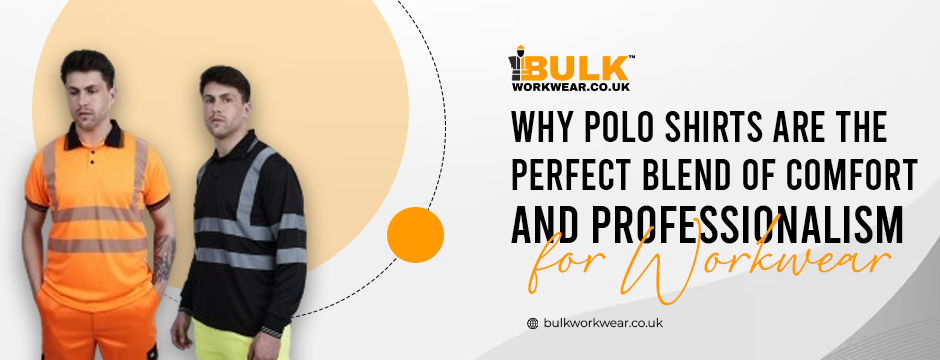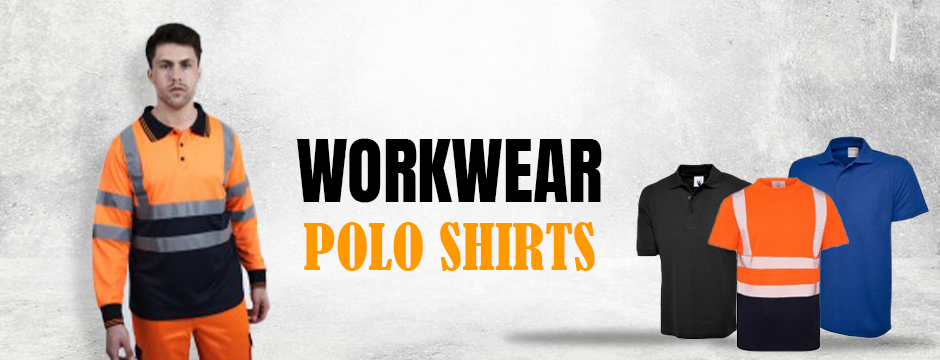Articles with tag: Workwear
Stay in the know with information from the workwear industry. Keeping you up to date with the latest workwear developments & releases.
Why Polo Shirts Are the Perfect Blend of Comfort and Professionalism for Workwear

When it comes to maintaining a professional and neat appearance in the office, the attire is of greatest significance. Blending being comfortable and having a corporate look is difficult—particularly in busy work environments where employees must be moving around, feel comfortable, and look presentable all day. That is where polo shirts excel.
Why High Vis Workwear Is Essential for Workplace Safety

When it is a question of remaining visible in the workplace, nothing substitutes for being seen. Whether you work on a construction site, are directing traffic, or working out of a warehouse, visibility can be the difference between safety and severe harm. That is where high vis workwear enters — an integral element of personal protective equipment (PPE) which enables us to be seen, safeguarded, and ready.
Finding the Right Fit: A Guide to Selecting Workwear Polo Shirts

Among professional attires, workwear polo shirts top the lists of numerous employees in the workplace. These polo shirts provide comfort with style, making them the perfect garment for both work and relaxation. Whether you seek the traditional look of a black polo, an attention-grabbing red polo, or maybe one that enhances safety through visibility, choosing a comfortable fit does matter. Let us guide you to find that workwear polo that would definitely fit right in terms of providing comfort during those long work hours.
Gender-Specific High-Visibility Workwear: Meeting the Needs of All Workers
Gender-specific high-visibility workwear is becoming increasingly important as more women join industries like construction, manufacturing, and emergency services. Traditional hi-vis workwear is often designed to fit men's body shapes, leaving women with ill-fitting and uncomfortable gear. Gender-specific hi-vis workwear addresses this issue by offering clothing that fits women more comfortably, providing better safety and visibility.
Hi-vis jackets and trousers designed for women have more tailored fits that align with their body shapes, allowing for better movement and coverage. This ensures that the reflective strips and fluorescent materials are placed in the right areas, enhancing visibility in low-light conditions. By providing gender-specific hi-vis gear, employers can improve comfort, safety, and productivity for all workers.
Hi-Vis Workwear for Cyclists and Pedestrians: Staying Safe on the Road
1. Best Hi-Vis Workwear for Cyclists and Pedestrians
For cyclists and pedestrians, high-visibility workwear is essential for staying safe on the road. Hi-vis vests and jackets with reflective strips ensure visibility to drivers, especially in low-light or nighttime conditions. Fluorescent colours like yellow, orange, or green help cyclists and pedestrians stand out during the day.
For added safety, consider reflective armbands, ankle bands, and LED safety lights to enhance visibility from all angles. By wearing the right hi-vis gear, cyclists and pedestrians can reduce the risk of accidents and ensure they remain visible on the road.
Best Practices for High-Visibility Workwear in Traffic Management
1. Best High-Visibility Workwear for Traffic Management Safety
In traffic management, ensuring workers are
visible to drivers is critical for safety. The best high visibility workwear
for traffic management includes Class 3 hi-vis jackets and trousers
with reflective strips. These garments provide full-body visibility,
ensuring workers are seen from a distance, even in low-light or nighttime
conditions.
For added protection, hi-vis helmets
and reflective gloves are also essential. Workers should choose clothing
with fluorescent colours such as yellow or orange to ensure they stand
out against road surfaces, construction zones, and other backgrounds. By
equipping traffic management workers with the best hi-vis workwear, employers
can significantly reduce the risk of accidents.
Top Safety Accessories to Pair with Your High-Visibility Workwear
1. Best Safety Accessories to Pair with Hi-Vis Workwear
To maximise safety while wearing hi-vis workwear, it’s essential to pair it with the right accessories. Reflective gloves, helmets, and boots with reflective strips enhance visibility, ensuring workers are seen from head to toe. Hi-vis hard hats and eye protection are also crucial for protecting workers in construction, road work, or industrial environments.
Adding reflective armbands or LED safety lights further increases visibility, especially in low-light conditions. By pairing hi-vis workwear with these accessories, employers can ensure full-body protection and enhance worker safety on the job.
How to Layer High-Visibility Clothing for Ultimate Comfort and Safety
1. How to Layer Hi-Vis Clothing for Maximum Comfort and Protection
Layering high visibility clothing is essential for ensuring both comfort and safety, particularly in environments where the weather changes frequently. Start with a lightweight, moisture-wicking base layer to keep sweat away from the body, followed by a mid-layer for insulation, such as a fleece or thermal shirt. Finally, top it off with a Class 3 hi-vis jacket or vest for maximum visibility.
By layering your hi-vis clothing, you can easily add or remove layers depending on the weather, ensuring you stay comfortable while maintaining full-body protection and visibility.
Custom Branding on High-Visibility Workwear: Practicality Meets Promotion
How Custom Branding on Hi-Vis Workwear Boosts Company Visibility
Custom branding on high-visibility workwear offers more than just safety—it also boosts a company’s visibility in the public eye. Adding your company logo or brand name to hi-vis clothing ensures that your team stands out, not only for safety but also as a promotional tool.
Workers wearing branded hi-vis gear become walking advertisements, helping to promote your business wherever they go. Whether on a construction site, a road project, or in public spaces, custom-branded hi-vis workwear reinforces your company’s presence and professional image.
By incorporating custom branding into your hi-vis clothing, you combine safety with effective marketing, boosting both visibility and brand awareness.
High-Visibility Workwear: Differences Between Class 1, 2, and 3
Class 1 vs. Class 3 High-Visibility Clothing: What’s the Difference?
High-visibility clothing is divided into different classes based on the level of visibility required. Class 1 provides the minimum visibility, while Class 3 offers the highest level of protection. The difference between these classes lies in the amount of fluorescent material and reflective tape used in the clothing.
- Class 1 clothing is typically used in low-risk environments, such as warehouses or parking attendants.
- Class 3 clothing, on the other hand, is designed for high-risk environments, such as roadwork or railways, where workers need to be visible from a greater distance.
Understanding these differences is essential for ensuring that workers have the right level of protection for their specific job.
Understanding High-Visibility Workwear Classes: Class 1, 2, and 3 Explained
High-visibility workwear is classified into three categories—Class 1, 2, and 3—based on the amount of visible material and reflective surfaces. Each class corresponds to different levels of risk and visibility requirements:
- Class 1: Used for lower-risk jobs like warehouse work. These garments feature less reflective material.
- Class 2: Mid-level protection, ideal for road workers or construction sites.
- Class 3: Maximum visibility for high-risk environments, such as motorways or railways. These garments feature full-body reflective coverage.
By understanding the different classes, employers can select the appropriate clothing to match their workers’ needs.
